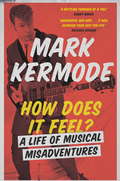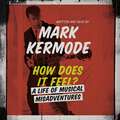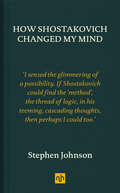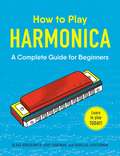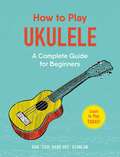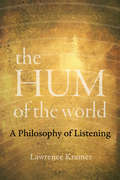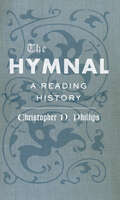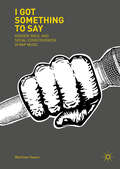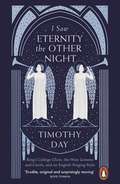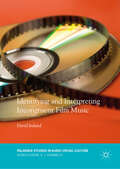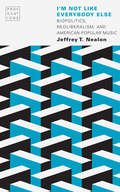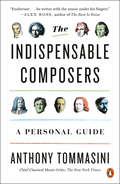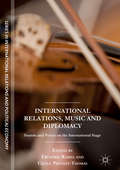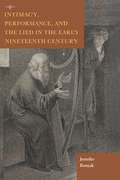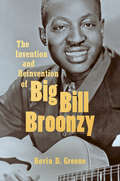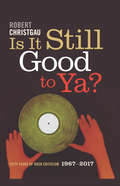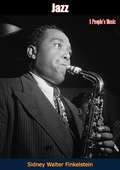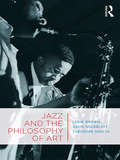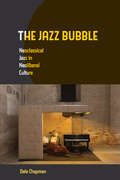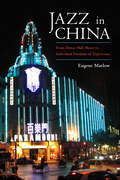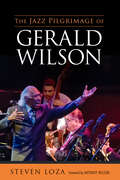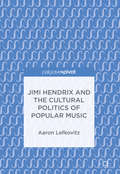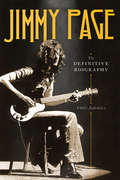- Table View
- List View
How Does It Feel?: A Life of Musical Misadventures
by Mark Kermode'Wonderful - such a terrific read. Brilliantly captures the passion, commitment, searing self-knowledge and dizzy happiness that comes with loving music. An enchanting book' STEPHEN FRY***Following a formative encounter with the British pop movie Slade in Flame in 1975, Mark Kermode decided that musical superstardom was totally attainable. And so, armed with a homemade electric guitar and very little talent, he embarked on an alternative career - a chaotic journey which would take him from the halls and youth clubs of North London to the stages of Glastonbury, the London Palladium and The Royal Albert Hall. Hilarious and blissfully nostalgic, this is a riotous account of a bedroom dreamer's attempts to conquer the world armed with nothing more than a chancer's enthusiasm and a simple philosophy: how hard can it be? *** 'At the heart of this entertaining memoir is a little boy in his back garden in Finchley, banging out a rhythm on saucepans with a couple of wooden spoons' Daily Mail'A rocking whirlwind of a tale' DANNY BAKER'Wonderful . . . will increase your zest for life' RICHARD AYOADE'Entertaining . . . what comes through every anecdote is the author's genuine enthusiasm for music' Spectator
How Does It Feel?: A Life of Musical Misadventures
by Mark KermodeFollowing a formative encounter with the British pop movie Slade in Flame in 1975, Mark Kermode decided that musical superstardom was totally attainable. And so, armed with a homemade electric guitar and very little talent, he embarked on an alternative career - a chaotic journey which would take him from the halls and youth clubs of North London to the stages of Glastonbury, the London Palladium and The Royal Albert Hall.HOW DOES IT FEEL? follows a lifetime of musical misadventures which have seen Mark striking rockstar poses in the Sixth Form Common Room, striding around a string of TV shows dressed from head to foot in black leather, getting heckled off stage by a bunch of angry septuagenarians on a boat on the Mersey, showing Timmy Mallet how to build a tea-chest bass - and winning the International Street Entertainers of the Year award as part of a new wave of skiffle. Really. Hilarious, self-deprecating and blissfully nostalgic, this is a riotous account of a bedroom dreamer's attempts to conquer the world armed with nothing more than a chancer's enthusiasm and a simple philosophy: how hard can it be?
How Does It Feel?: A Life of Musical Misadventures
by Mark KermodeFollowing a formative encounter with the British pop movie Slade in Flame in 1975, Mark Kermode decided that musical superstardom was totally attainable. And so, armed with a homemade electric guitar and very little talent, he embarked on an alternative career - a chaotic journey which would take him from the halls and youth clubs of North London to the stages of Glastonbury, the London Palladium and The Royal Albert Hall.HOW DOES IT FEEL? follows a lifetime of musical misadventures which have seen Mark striking rockstar poses in the Sixth Form Common Room, striding around a string of TV shows dressed from head to foot in black leather, getting heckled off stage by a bunch of angry septuagenarians on a boat on the Mersey, showing Timmy Mallet how to build a tea-chest bass - and winning the International Street Entertainers of the Year award as part of a new wave of skiffle. Really. Hilarious, self-deprecating and blissfully nostalgic, this is a riotous account of a bedroom dreamer's attempts to conquer the world armed with nothing more than a chancer's enthusiasm and a simple philosophy: how hard can it be?Written and Read by Mark KermodeMusic samples from the album 'Drive Train' are reproduced with kind permission from The Dodge Brothers(P) Orion Publishing Group 2018
How Shostakovich Changed My Mind
by Stephen JohnsonA powerful look at the extraordinary healing effect of music on sufferers of mental illness, including author Stephen Johnson's struggle with bipolar disorder.BBC music broadcaster Stephen Johnson explores the power of Shostakovich’s music during Stalin’s reign of terror, and writes of the extraordinary healing effect of music on sufferers of mental illness. Johnson looks at neurological, psychotherapeutic and philosophical findings, and reflects on his own experience, where he believes Shostakovich’s music helped him survive the trials and assaults of bipolar disorder.There is no escapism, no false consolation in Shostakovich’s greatest music: this is some of the darkest, saddest, at times bitterest music ever composed. So why do so many feel grateful to Shostakovich for having created it—not just Russians, but westerners like Stephen Johnson, brought up in a very different, far safer kind of society? The book includes interviews with the members of the orchestra who performed Shostakovich’s Leningrad Symphony during the siege of that city.
How to Play Harmonica: A Complete Guide for Beginners (How to Play)
by Blake Brocksmith Gary Dorfman Douglas LichtermanThis easy-to-understand beginner’s guide provides an introduction to playing the harmonica and includes helpful information about basic techniques, tools, and music knowledge.Learn to play the harmonica with this step-by-step guide perfect for beginners. With just this book and your harmonica in hand, you’ll learn basic music skills, discover how and why your harmonica works, play some simple tunes, and start to improvise your own music.
How to Play Ukulele: A Complete Guide for Beginners (How to Play)
by Dan ScanlanLearn to play the ukulele with this beginner’s guide that features information about basic techniques, tools, and music knowledge.What do George Clooney, Zooey Deschanel, Ryan Gosling and James Franco all have in common? Answer: they all play the ukulele and now, with this easy step-by-step guide, you can too! With just this book and your ukulele in hand, you’ll learn basic music skills, how to care for your instrument, and how to play some simple tunes. Whether you’re looking to impress your friends with spontaneous singalongs, or just want to strum solo, How to Play Ukulele is the perfect entryway to the wonderful world of ukulele.
The Hum of the World: A Philosophy of Listening
by Lawrence KramerThe Hum of the World is an invitation to contemplate what would happen if we heard the world as attentively as we see it. Balancing big ideas with playful wit and lyrical prose, this imaginative volume identifies the role of sound in Western experience as the primary medium in which the presence and persistence of life acquire tangible form. The positive experience of aliveness is not merely in accord with sound, but inaccessible, even inconceivable, without it. Lawrence Kramer’s poetic book roves freely over music, media, language, philosophy, and science from the ancient world to the present, along the way revealing how life is apprehended through sounds ranging from pandemonium to the faint background hum of the world. Easily moving from reflections on pivotal texts and music to the introduction of elemental concepts, this warm meditation on auditory culture uncovers the knowledge and pleasure made available when we recognize that the world is alive with sound.
The Hymnal: A Reading History
by Christopher N. PhillipsUnderstanding the culture of living with hymnbooks offers new insight into the histories of poetry, literacy, and religious devotion.It stands barely three inches high, a small brick of a book. The pages are skewed a bit, and evidence of a small handprint remains on the worn, cheap leather covers that don’t quite close. The book bears the marks of considerable use. But why—and for whom—was it made? Christopher N. Phillips’s The Hymnal is the first study to reconstruct the practices of reading and using hymnals, which were virtually everywhere in the eighteenth and nineteenth centuries. Isaac Watts invented a small, words-only hymnal at the dawn of the eighteenth century. For the next two hundred years, such hymnals were their owners’ constant companions at home, school, church, and in between. They were children's first books, slaves’ treasured heirlooms, and sources of devotional reading for much of the English-speaking world. Hymnals helped many people learn to memorize poetry and to read; they provided space to record family memories, pass notes in church, and carry everything from railroad tickets to holy cards to business letters. In communities as diverse as African Methodists, Reform Jews, Presbyterians, Methodists, Roman Catholics, and Unitarians, hymnals were integral to religious and literate life. An extended historical treatment of the hymn as a read text and media form, rather than a source used solely for singing, this book traces the lives people lived with hymnals, from obscure schoolchildren to Emily Dickinson. Readers will discover a wealth of connections between reading, education, poetry, and religion in Phillips’s lively accounts of hymnals and their readers.
I Got Something to Say: Gender, Race, and Social Consciousness in Rap Music
by Matthew OwareWhat do millennial rappers in the United States say in their music? This timely and compelling book answers this question by decoding the lyrics of over 700 songs from contemporary rap artists. Using innovative research techniques, Matthew Oware reveals how emcees perpetuate and challenge gendered and racialized constructions of masculinity, femininity, and sexuality. Male and female artists litter their rhymes with misogynistic and violent imagery. However, men also express a full range of emotions, from arrogance to vulnerability, conveying a more complex manhood than previously acknowledged. Women emphatically state their desires while embracing a more feminist approach. Even LGBTQ artists stake their claim and express their sexuality without fear. Finally, in the age of Black Lives Matter and the presidency of Donald J. Trump, emcees forcefully politicize their music. Although complicated and contradictory in many ways, rap remains a powerful medium for social commentary.
I Saw Eternity the Other Night: King's College, Cambridge, and an English Singing Style
by Timothy DayThe sound of the choir of King's College, Cambridge - its voices perfectly blended, its emotions restrained, its impact sublime - has become famous all over the world, and for many, the distillation of a particular kind of Englishness. This is especially so at Christmas time, with the broadcast of the Festival of Nine Lessons and Carols, whose centenary is celebrated this year. How did this small band of men and boys in a famous fenland town in England come to sing in the extraordinary way they did in the twentieth and early twenty-first centuries?It has been widely assumed that the King's style essentially continues an English choral tradition inherited directly from the Middle Ages. In this original and illuminating book, Timothy Day shows that this could hardly be further from the truth. Until the 1930s, the singing at King's was full of high Victorian emotionalism, like that at many other English choral foundations well into the twentieth century.The choir's modern sound was brought about by two intertwined revolutions, one social and one musical. From 1928, singing with the trebles in place of the old lay clerks, the choir was fully made up of choral scholars - college men, reading for a degree. Under two exceptional directors of music - Boris Ord from 1929 and David Willcocks from 1958 - the style was transformed and the choir broadcast and recorded until it became the epitome of English choral singing, setting the benchmark for all other choral foundations either to imitate or to react against. Its style has now been taken over and adapted by classical performers who sing both sacred and secular music in secular settings all over the world with a precision inspired by the King's tradition.I Saw Eternity the Other Night investigates the timbres of voices, the enunciation of words, the use of vibrato. But the singing of all human beings, in whatever style, always reflects in profound and subtle ways their preoccupations and attitudes to life. These are the underlying themes explored by this book.
Identifying and Interpreting Incongruent Film Music (Palgrave Studies in Audio-Visual Culture)
by David IrelandThis book explores the concept of incongruent film music, challenging the idea that this label only describes music that is inappropriate or misfitting for a film’s images and narrative. Defining incongruence as a lack of shared properties in the audiovisual relationship, this study examines various types of incongruence between a film and its music and considers the active role that it can play in the construction of a film’s meaning and influencing audience response. Synthesising findings from research in the psychology of music in multimedia, as well as from ideas sourced in semiotics, film music, and poststructuralist theory, this interdisciplinary book provides a holistic perspective that reflects the complexity of moments of film-music incongruence. With case studies including well-known films such as Gladiator and The Shawshank Redemption, this book combines scene analysis and empirical audience reception tests to emphasise the subjectivity, context-dependency, and multi-dimensionality inherent in identifying and interpreting incongruent film music.
I'm Not Like Everybody Else: Biopolitics, Neoliberalism, and American Popular Music (Provocations)
by Jeffrey T. NealonDespite the presence of the Flaming Lips in a commercial for a copier and Iggy Pop’s music in luxury cruise advertisements, Jeffrey T. Nealon argues that popular music has not exactly been co-opted in the American capitalist present. Contemporary neoliberal capitalism has, in fact, found a central organizing use for the values of twentieth-century popular music: being authentic, being your own person, and being free. In short, not being like everybody else. Through a consideration of the shift in dominant modes of power in the American twentieth and twenty-first centuries, from what Michel Foucault calls a dominant “disciplinary” mode of power to a “biopolitical” mode, Nealon argues that the modes of musical “resistance” need to be completely rethought and that a commitment to musical authenticity or meaning—saying “no” to the mainstream—is no longer primarily where we might look for music to function against the grain. Rather, it is in the technological revolutions that allow biopolitical subjects to deploy music within an everyday set of practices (MP3 listening on smartphones and iPods, streaming and downloading on the internet, the background music that plays nearly everywhere) that one might find a kind of ambient or ubiquitous answer to the “attention capitalism” that has come to organize neoliberalism in the American present. In short, Nealon stages the final confrontation between “keepin’ it real” and “sellin’ out.”
The Indispensable Composers: A Personal Guide
by Anthony TommasiniAn exploration into the question of greatness from the Chief Classical Music Critic of the New York TimesWhen he began to listen to the great works of classical music as a child, Anthony Tommasini had many questions. Why did a particular piece move him? How did the music work? Over time, he realized that his passion for this music was not enough. He needed to understand it. Take Bach, for starters. Who was he? How does one account for his music and its unshakeable hold on us today? As a critic, Tommasini has devoted particular attention to living composers and overlooked repertory. But, like all classical music lovers, the canon has remained central for him. In 2011, in his role as the Chief Classical Music Critic for the New York Times, he wrote a popular series in which he somewhat cheekily set out to determine the all-time top ten composers. Inviting input from readers, Tommasini wrestled with questions of greatness. Readers joined the exercise in droves. Some railed against classical music’s obsession with greatness but then raged when Mahler was left off the final list. This intellectual game reminded them why they loved music in the first place. Now in THE INDISPENSABLE COMPOSERS, Tommasini offers his own personal guide to the canon--and what greatness really means in classical music. What does it mean to be canonical now? Who gets to say? And do we have enough perspective on the 20th century to even begin assessing it? To make his case, Tommasini draws on elements of biography, the anxiety of influence, the composer's relationships with colleagues, and shifting attitudes toward a composer's work over time. Because he has spent his life contemplating these titans, Tommasini shares impressions from performances he has heard or given or moments when his own biography proves revealing. As he argues for his particular pantheon of indispensable composers, Anthony Tommasini provides a masterclass in what to listen for and how to understand what music does to us.
The Individualist: Digressions, Dreams and Dissertations
by Todd RundgrenThe author, a multi-talented producer and musician with such hits as "Hello It's Me," "Can We Still Be Friends," "Earth Mother," and "Everybody" describes in one-page anecdotes his childhood and adult life. He discusses the struggle growing up with a neglectful father, his antics with his best friend, memories of childhood injuuries--all with summary conclusions and witty, and sometimes profound, philosophy.
International Relations, Music and Diplomacy
by Frédéric Ramel Cécile Prévost-ThomasThis volume explores the interrelation of international relations, music, and diplomacy from a multidisciplinary perspective. Throughout history, diplomats have gathered for musical events, and musicians have served as national representatives. Whatever political unit is under consideration (city-states, empires, nation-states), music has proven to be a component of diplomacy, its ceremonies, and its strategies. Following the recent acoustic turn in IR theory, the authors explore the notion of “musical diplomacies” and ask whether and how it differs from other types of cultural diplomacy. Accordingly, sounds and voices are dealt with in acoustic terms but are not restricted to music per se, also taking into consideration the voices (speech) of musicians in the international arena.Read an interview with the editors here: https://www.sciencespo.fr/ceri/en/content/international-relations-music-and-diplomacy-sounds-and-voices-international-stage
Intimacy, Performance, and the Lied in the Early Nineteenth Century (Historical Performance)
by Jennifer RonyakThe German lied, or art song, is considered one of the most intimate of all musical genres—often focused on the poetic speaker’s inner world and best suited for private and semi-private performance in the home or salon. Yet, problematically, any sense of inwardness in lieder depends on outward expression through performance. With this paradox at its heart, Intimacy, Performance, and the Lied in the Early Nineteenth Century explores the relationships between early nineteenth-century theories of the inward self, the performance practices surrounding inward lyric poetry and song, and the larger conventions determining the place of intimate poetry and song in the public concert hall. Jennifer Ronyak studies the cultural practices surrounding lieder performances in northern and central Germany in the first quarter of the nineteenth century, demonstrating how presentations of lieder during the formative years of the genre put pressure on their sense of interiority. She examines how musicians responded to public concern that outward expression would leave the interiority of the poet, the song, or the performer unguarded and susceptible to danger. Through this rich performative paradox Ronyak reveals how a song maintains its powerful intimacy even during its inherently public performance.
The Invention and Reinvention of Big Bill Broonzy
by Kevin D. GreeneOver the course of his long career, legendary bluesman William "Big Bill" Broonzy (1893–1958) helped shape the trajectory of the genre, from its roots in the rural Mississippi River Delta, through its rise as a popular genre in the North, to its eventual international acclaim. Along the way, Broonzy adopted an evolving personal and professional identity, tailoring his self-presentation to the demands of the place and time. His remarkable professional fluidity mirrored the range of expectations from his audiences, whose ideas about race, national belonging, identity, and the blues were refracted through Broonzy as if through a prism. Kevin D. Greene argues that Broonzy's popular success testifies to his ability to navigate the cultural expectations of his different audiences. However, this constant reinvention came at a personal and professional cost. Using Broonzy's multifaceted career, Greene situates blues performance at the center of understanding African American self-presentation and racial identity in the first half of the twentieth century. Through Broonzy's life and times, Greene assesses major themes and events in African American history, including the Great Migration, urbanization, and black expatriate encounters with European culture consumers. Drawing on a range of historical source materials as well as oral histories and personal archives held by Broonzy's son, Greene perceptively interrogates how notions of race, gender, and audience reception continue to shape concepts of folk culture and musical authenticity.
Is It Still Good to Ya?: Fifty Years of Rock Criticism, 1967-2017
by Robert ChristgauIs It Still Good to Ya? sums up the career of longtime Village Voice stalwart Robert Christgau, who for half a century has been America's most widely respected rock critic, honoring a music he argues is only more enduring because it's sometimes simple or silly. While compiling historical overviews going back to Dionysus and the gramophone along with artist analyses that range from Louis Armstrong to M.I.A., this definitive collection also explores pop's African roots, response to 9/11, and evolution from the teen music of the '50s to an art form compelled to confront mortality as its heroes pass on. A final section combines searching obituaries of David Bowie, Prince, and Leonard Cohen with awed farewells to Bob Marley and Ornette Coleman.
Jazz: A People’s Music
by Sidney Walter FinkelsteinTHE PLACE OF JAZZ IN WORLD MUSIC…ITS HISTORY FROM NEW ORLEANS TO THE PRESENT DAY…ITS BEAUTY AS MUSIC…AND THE GREATNESS OF THE PEOPLE WHO MADE IT…This is a book for everyone who loves music—classical or jazz; for the one who performs or the one who makes up his audience. To either one it will contribute much for a better understanding and appreciation of this greatest and most widely participated in art.Everyone knows about jazz. We listen to it, we sing it, play it and dance to it. Yet it is the great unknown music.Jazz, A People’s Music describes all the developments of jazz from the early blues to present-day “bebop.” And just as the study of a composer’s music must include the man himself, here is an account of the growth of jazz as well as the study of all the American people, of every nationality and color, who have nurtured and welcomed this music and brought new and exciting variations of it into being.
Jazz and the Philosophy of Art
by Lee B. Brown David Goldblatt Theodore GracykCo-authored by three prominent philosophers of art, Jazz and the Philosophy of Art is the first book in English to be exclusively devoted to philosophical issues in jazz. It covers such diverse topics as minstrelsy, bebop, Voodoo, social and tap dancing, parades, phonography, musical forgeries, and jazz singing, as well as Goodman’s allographic/autographic distinction, Adorno’s critique of popular music, and what improvisation is and is not. The book is organized into three parts. Drawing on innovative strategies adopted to address challenges that arise for the project of defining art, Part I shows how historical definitions of art provide a blueprint for a historical definition of jazz. Part II extends the book’s commitment to social-historical contextualism by exploring distinctive ways that jazz has shaped, and been shaped by, American culture. It uses the lens of jazz vocals to provide perspective on racial issues previously unaddressed in the work. It then examines the broader premise that jazz was a socially progressive force in American popular culture. Part III concentrates on a topic that has entered into the arguments of each of the previous chapters: what is jazz improvisation? It outlines a pluralistic framework in which distinctive performance intentions distinguish distinctive kinds of jazz improvisation. This book is a comprehensive and valuable resource for any reader interested in the intersections between jazz and philosophy.
The Jazz Bubble: Neoclassical Jazz In Neoliberal Culture
by Dale ChapmanHailed by corporate, philanthropic, and governmental organizations as a metaphor for democratic interaction and business dynamics, contemporary jazz culture has a story to tell about the relationship between political economy and social practice in the era of neoliberal capitalism. The Jazz Bubble approaches the emergence of the neoclassical jazz aesthetic since the 1980s as a powerful, if unexpected, point of departure for a wide-ranging investigation of important social trends during this period, extending from the effects of financialization in the music industry to the structural upheaval created by urban redevelopment in major American cities. Dale Chapman draws from political and critical theory, oral history, and the public and trade press, making this a persuasive and compelling work for scholars across music, industry, and cultural studies.
Jazz in China: From Dance Hall Music to Individual Freedom of Expression
by Eugene MarlowFinalist for the 2019 Jazz Journalists Association Book of the Year About Jazz, Jazz Awards for Journalism"Is there jazz in China?" This is the question that sent author Eugene Marlow on his quest to uncover the history of jazz in China. Marlow traces China's introduction to jazz in the early 1920s, its interruption by Chinese leadership under Mao in 1949, and its rejuvenation in the early 1980s with the start of China's opening to the world under Premier Deng Xiaoping.Covering a span of almost one hundred years, Marlow focuses on a variety of subjects--the musicians who initiated jazz performances in China, the means by which jazz was incorporated into Chinese culture, and the musicians and venues that now present jazz performances.Featuring unique, face-to-face interviews with leading indigenous jazz musicians in Beijing and Shanghai, plus interviews with club owners, promoters, expatriates, and even diplomats, Marlow marks the evolution of jazz in China as it parallels China's social, economic, and political evolution through the twentieth and into the twenty-first century. Also featured is an interview with one of the extant members of the Jimmy King Big Band of the 1940s, one of the first major all-Chinese jazz big bands in Shanghai.Ultimately, Jazz in China: From Dance Hall Music to Individual Freedom of Expression is a cultural history that reveals the inexorable evolution of a democratic form of music in a Communist state.
The Jazz Pilgrimage of Gerald Wilson (American Made Music Series)
by Steven LozaJazz great Gerald Wilson (1918-2014), born in Shelby, Mississippi, left a global legacy of paramount significance through his progressive musical ideas and his orchestra's consistent influence on international jazz. Aided greatly by interviews that bring Wilson's voice to the story, Steven Loza presents a perspective on what the musician and composer called his "jazz pilgrimage."Wilson uniquely adapted Latin influences into his jazz palette, incorporating many Cuban and Brazilian inflections as well as those of Mexican and Spanish styling. Throughout the book, Loza refers to Wilson's compositions and arrangements, including their historical contexts and motivations. Loza provides savvy musical readings and analysis of the repertoire. He concludes by reflecting upon Wilson's ideas on the place of jazz culture in America, its place in society and politics, its origins, and its future.With a foreword written by Wilson's son, Anthony, and such sources as essays, record notes, interviews, and Wilson's own reflections, the biography represents the artist's ideas with all their philosophical, historical, and cultural dimensions. Beyond merely documenting Wilson's many awards and recognitions, this book ushers readers into the heart and soul of a jazz creator. Wilson emerges a unique and proud African American artist whose tunes became a mosaic of the world.
Jimi Hendrix and the Cultural Politics of Popular Music
by Aaron LefkovitzThis book, on Jimi Hendrix’s life, times, visual-cultural prominence, and popular music, with a particular emphasis on Hendrix’s relationships to the cultural politics of race, gender, sexuality, ethnicity, class, and nation. Hendrix, an itinerant “Gypsy” and “Voodoo child” whose racialized “freak” visual image continues to internationally circulate, exploited the exoticism of his race, gender, and sexuality and Gypsy and Voodoo transnational political cultures and religion. Aaron E. Lefkovitz argues that Hendrix can be located in a legacy of black-transnational popular musicians, from Chuck Berry to the hip hop duo Outkast, confirming while subverting established white supremacist and hetero-normative codes and conventions. Focusing on Hendrix’s transnational biography and centrality to US and international visual cultural and popular music histories, this book links Hendrix to traditions of blackface minstrelsy, international freak show spectacles, black popular music’s global circulation, and visual-cultural racial, gender, and sexual stereotypes, while noting Hendrix’s place in 1960s countercultural, US-exceptionalist, cultural Cold War, and rock histories.
Jimmy Page: The Definitive Biography
by Chris SalewiczAn in-depth biography of Led Zeppelin guitarist Jimmy Page by the acclaimed biographer of Bob Marley and Joe Strummer, based upon the author's extensive research and interviewsThe original enigmatic rock star, Jimmy Page is a mass of contradictions. A towering presence in the guitar world and one of the most revered rock guitarists of all time, in private he is reclusive and mysterious, retiring and given to esoteric interests. Over the decades he has exchanged few words to the press given the level of his fame, and an abiding interest in the demonic and supernatural has only made the myth more potent.But in the midst of this maelstrom, who was Jimmy Page? Rock journalist Chris Salewicz has conducted numerous interviews with Page over the years and has created the first portrait of the guitarist that can be called definitive, penetrating the shadows that surround him to reveal the fascinating man who dwells within the rock legend.
